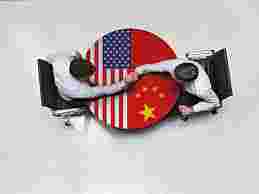Introduction
The US China trade war, which began in 2018, continues to shape global trade, supply chains, and economic policies in 2025. While some tensions have eased through negotiations, tariffs, and retaliatory measures, the competition between the world’s two largest economies remains a central issue in international trade, technology, and geopolitics.
This article examines the causes, economic impacts, technological competition, and future outlook of the US–China trade war in 2025.
Causes of the US China Trade War
- Trade Imbalances – The US has historically run a large trade deficit with China, leading to calls for fairer trade practices.
- Intellectual Property (IP) Concerns – Allegations of IP theft and forced technology transfers fueled US tariffs.
- Market Access Issues – Restrictions on foreign companies operating in China prompted US intervention.
- Strategic Competition – Beyond economics, the trade war reflects broader geopolitical rivalry over global influence, technology leadership, and military power.
Key Developments by 2025
- Tariff Measures: Both nations maintain selective tariffs on products ranging from electronics to agriculture.
- Phase Agreements: Several rounds of negotiations have led to partial tariff reductions and commitments on trade balance.
- Technology Restrictions: The US continues to limit China’s access to critical technologies, including semiconductors, AI, and quantum computing.
- Supply Chain Reconfigurations: Companies are relocating manufacturing to Southeast Asia, India, and Mexico to reduce dependency.
Economic Impacts
1. on the United States
- Inflation: Tariffs have increased costs of imports, affecting consumers and businesses.
- Manufacturing Shifts: US companies diversify supply chains but face increased operational costs.
- Agricultural Sector: Farmers face challenges due to retaliatory tariffs on soybeans, corn, and meat exports.
2. on China
- Export Pressure: Chinese exporters adapt by targeting new markets in Africa, Latin America, and Europe.
- Economic Growth: Tariffs and trade barriers slightly slow India GDP growth, prompting stimulus measures.
- Technological Development: China accelerates domestic R&D in AI, 5G, and semiconductors to achieve self-reliance.
3. Global Economy
- Supply Chain Disruption: Electronics, automotive, and tech industries face higher costs and delays.
- Emerging Markets: Nations like India, Vietnam, and Indonesia benefit from shifting production and investment.
- Energy Markets: Trade tensions indirectly affect oil, LNG, and commodity prices due to economic uncertainty.
Technology and Strategic Competition
- Semiconductors: The US restricts exports of advanced chips to China, prompting China’s domestic production push.
- Artificial Intelligence: Both nations invest heavily in AI research, surveillance technology, and industrial automation.
- Quantum Computing: Technological supremacy in emerging fields is increasingly a point of strategic rivalry.
- Cybersecurity and Espionage: The trade war includes cyber measures, intellectual property protection, and state-sponsored hacking concerns.
Global Responses and Adaptations
- Diversification of Trade: Countries reduce reliance on the US China corridor, establishing new trade agreements like RCEP and bilateral pacts.
- Investment Shifts: Foreign direct investment flows to other Asian nations, benefiting from lower costs and stable policies.
- Policy Adjustments: Governments implement tariffs, subsidies, and export incentives to mitigate impacts of the trade war.
Future Outlook in 2025 and Beyond
- Partial De-escalation: Ongoing dialogue may reduce tariffs but strategic competition persists.
- Global Supply Chains: Multinational corporations will continue to diversify production to mitigate geopolitical risks.
- Technology Race: Competition in AI, 5G, and quantum computing will dominate US–China relations.
- Emerging Markets Opportunities: Countries like India may gain from increased manufacturing investments and trade diversification.
Conclusion
The US China trade war 2025 continues to influence global trade, technology development, and economic policies. While partial tariff reliefs and agreements have reduced immediate tensions, strategic rivalry and competition for technological supremacy remain unresolved. For the global economy, the trade war presents both challenges and opportunities, prompting nations to rethink supply chains, investment strategies, and economic partnerships.




